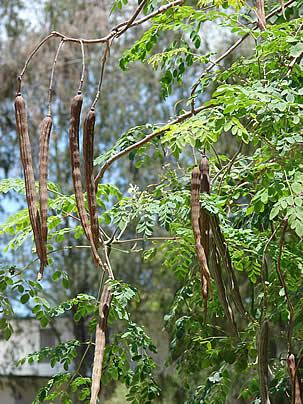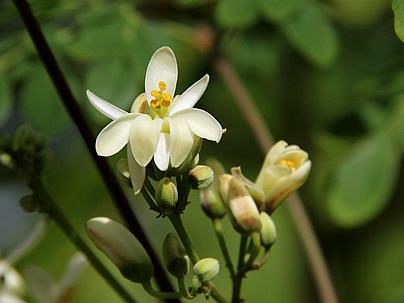The Drumstick Tree or Moringa (Moringa oleifera), as it is also known, is a small to medium-sized, deciduous, flowering tree with numerous uses. It is native to the Himalayas and has spread to various tropical and subtropical regions of the planet due to its numerous qualities, especially as a medicinal and food plant. It has a single erect trunk with a diameter of 8 to 18 inches (about 20 to 45 cm) and thick, whitish-gray bark.
Its crown is open, with pendulous, hirsute, and delicate branches that create an umbrella-like shape. The leaves are tripinnate, with elliptical to obovate leaflets of light green color, giving the overall appearance of the leaves a feathery look. It blooms year-round, producing clusters of small, hermaphroditic, fragrant, cream-white flowers. The subsequent fruits are long pendulous pods that open into three valves when mature, releasing numerous lightweight, papery, winged seeds.

The drumstick tree is primarily cultivated for its nutritional and medicinal value and is considered a miraculous plant. It is rich in nutrients, from proteins to vitamins, and has made a significant contribution to combating malnutrition in underdeveloped countries. It is also a powerful ally for vegetarians due to its high content of essential amino acids. Leaves, fruits, seeds, flowers, and roots can be consumed in various forms, from raw in juices, smoothies, salads to cooked in soups, snacks, and more.
The drumstick tree leaf powder is also used as a dietary supplement. The powder from its seeds has a similar effect to flocculation in water treatment, purifying, aggregating, and eliminating impurities and microorganisms, which quickly settle at the bottom of the container. See the table below for information on medicinal uses.
Its use in landscaping is still discreet but has great potential due to its thickened trunk, often giving it a somewhat bulging appearance, which adds an exotic touch to the garden. It provides light shade, about 50%, suitable for growing epiphytes and semi-shaded ground covers. Additionally, it blooms year-round. In some countries, it is also used as a potted plant, with its robust and sculptural caudex emphasized, similar to the Desert Rose (Adenium obesum).
It should be cultivated in preferably fertile, deep, well-draining, neutral to slightly acidic soil enriched with organic matter and regularly irrigated in the first year of establishment. Nevertheless, it can thrive in various types of soil, avoiding excessively dry or heavy, clayey soils prone to waterlogging.
Once well-established, the drumstick tree becomes tolerant of dry periods. It withstands mild frosts but thrives better in tropical heat. It responds well to fertilization and supplemental irrigation, producing more leaves and pods. It can be propagated by fresh seeds and stem cuttings from woody or semi-woody branches.


